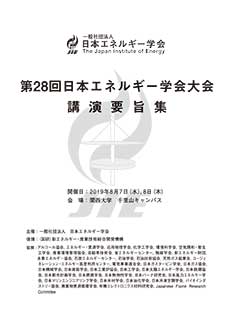第28回日本エネルギー学会大会
選択された号の論文の157件中51~100を表示しています
Session3
-
p. 82-83
発行日: 2019/07/31
公開日: 2019/07/31
PDF形式でダウンロード (572K) -
p. 84-85
発行日: 2019/07/31
公開日: 2019/07/31
PDF形式でダウンロード (591K) -
p. 86-87
発行日: 2019/07/31
公開日: 2019/07/31
PDF形式でダウンロード (1321K) -
p. 88-89
発行日: 2019/07/31
公開日: 2019/07/31
PDF形式でダウンロード (430K) -
p. 90-91
発行日: 2019/07/31
公開日: 2019/07/31
PDF形式でダウンロード (322K) -
p. 92-93
発行日: 2019/07/31
公開日: 2019/07/31
PDF形式でダウンロード (455K) -
p. 94-95
発行日: 2019/07/31
公開日: 2019/07/31
PDF形式でダウンロード (527K) -
p. 96-97
発行日: 2019/07/31
公開日: 2019/07/31
PDF形式でダウンロード (1386K) -
p. 98-99
発行日: 2019/07/31
公開日: 2019/07/31
PDF形式でダウンロード (431K) -
p. 100-101
発行日: 2019/07/31
公開日: 2019/07/31
PDF形式でダウンロード (464K) -
p. 102-103
発行日: 2019/07/31
公開日: 2019/07/31
PDF形式でダウンロード (554K) -
p. 104-105
発行日: 2019/07/31
公開日: 2019/07/31
PDF形式でダウンロード (698K) -
p. 106-107
発行日: 2019/07/31
公開日: 2019/07/31
PDF形式でダウンロード (416K) -
p. 108-109
発行日: 2019/07/31
公開日: 2019/07/31
PDF形式でダウンロード (343K) -
p. 110-111
発行日: 2019/07/31
公開日: 2019/07/31
PDF形式でダウンロード (384K) -
p. 112-113
発行日: 2019/07/31
公開日: 2019/07/31
PDF形式でダウンロード (279K) -
p. 114-115
発行日: 2019/07/31
公開日: 2019/07/31
PDF形式でダウンロード (323K) -
p. 116-117
発行日: 2019/07/31
公開日: 2019/07/31
PDF形式でダウンロード (515K) -
p. 118-119
発行日: 2019/07/31
公開日: 2019/07/31
PDF形式でダウンロード (738K)
Session4
-
p. 120-121
発行日: 2019/07/31
公開日: 2019/07/31
PDF形式でダウンロード (456K) -
p. 122-123
発行日: 2019/07/31
公開日: 2019/07/31
PDF形式でダウンロード (526K) -
p. 124-125
発行日: 2019/07/31
公開日: 2019/07/31
PDF形式でダウンロード (569K) -
p. 126-127
発行日: 2019/07/31
公開日: 2019/07/31
PDF形式でダウンロード (915K) -
p. 128-129
発行日: 2019/07/31
公開日: 2019/07/31
PDF形式でダウンロード (339K) -
p. 130-131
発行日: 2019/07/31
公開日: 2019/07/31
PDF形式でダウンロード (849K) -
p. 132-133
発行日: 2019/07/31
公開日: 2019/07/31
PDF形式でダウンロード (541K) -
p. 134-135
発行日: 2019/07/31
公開日: 2019/07/31
PDF形式でダウンロード (501K) -
p. 136-137
発行日: 2019/07/31
公開日: 2019/07/31
PDF形式でダウンロード (779K) -
p. 138-139
発行日: 2019/07/31
公開日: 2019/07/31
PDF形式でダウンロード (1018K) -
p. 140-141
発行日: 2019/07/31
公開日: 2019/07/31
PDF形式でダウンロード (496K) -
p. 142-143
発行日: 2019/07/31
公開日: 2019/07/31
PDF形式でダウンロード (619K) -
p. 144-145
発行日: 2019/07/31
公開日: 2019/07/31
PDF形式でダウンロード (458K) -
p. 146-147
発行日: 2019/07/31
公開日: 2019/07/31
PDF形式でダウンロード (472K) -
p. 148-149
発行日: 2019/07/31
公開日: 2019/07/31
PDF形式でダウンロード (484K) -
p. 150-151
発行日: 2019/07/31
公開日: 2019/07/31
PDF形式でダウンロード (1386K) -
p. 152-153
発行日: 2019/07/31
公開日: 2019/07/31
PDF形式でダウンロード (593K) -
p. 154-155
発行日: 2019/07/31
公開日: 2019/07/31
PDF形式でダウンロード (608K) -
p. 156-157
発行日: 2019/07/31
公開日: 2019/07/31
PDF形式でダウンロード (544K) -
p. 158-159
発行日: 2019/07/31
公開日: 2019/07/31
PDF形式でダウンロード (488K)
Session5
-
p. 160-161
発行日: 2019/07/31
公開日: 2019/07/31
PDF形式でダウンロード (451K) -
p. 162-163
発行日: 2019/07/31
公開日: 2019/07/31
PDF形式でダウンロード (1217K) -
p. 164-165
発行日: 2019/07/31
公開日: 2019/07/31
PDF形式でダウンロード (376K) -
p. 166-167
発行日: 2019/07/31
公開日: 2019/07/31
PDF形式でダウンロード (585K) -
p. 168-169
発行日: 2019/07/31
公開日: 2019/07/31
PDF形式でダウンロード (875K) -
p. 170-171
発行日: 2019/07/31
公開日: 2019/07/31
PDF形式でダウンロード (786K) -
p. 172-173
発行日: 2019/07/31
公開日: 2019/07/31
PDF形式でダウンロード (503K) -
p. 174-175
発行日: 2019/07/31
公開日: 2019/07/31
PDF形式でダウンロード (570K) -
p. 176-177
発行日: 2019/07/31
公開日: 2019/07/31
PDF形式でダウンロード (356K)
Session6
-
p. 178-179
発行日: 2019/07/31
公開日: 2019/07/31
PDF形式でダウンロード (268K) -
p. 180-181
発行日: 2019/07/31
公開日: 2019/07/31
PDF形式でダウンロード (461K)
